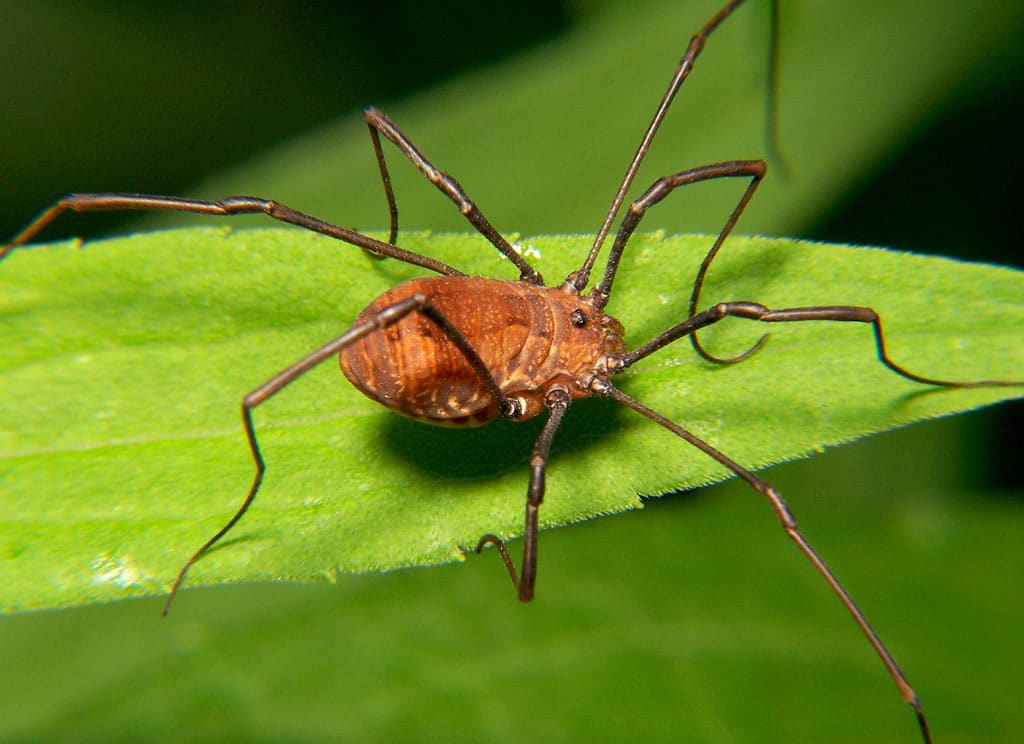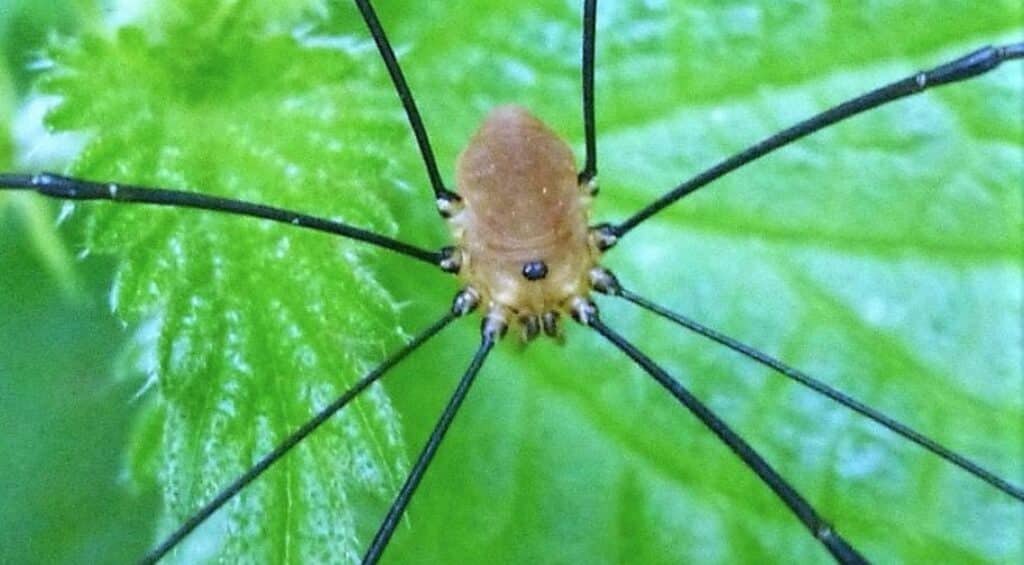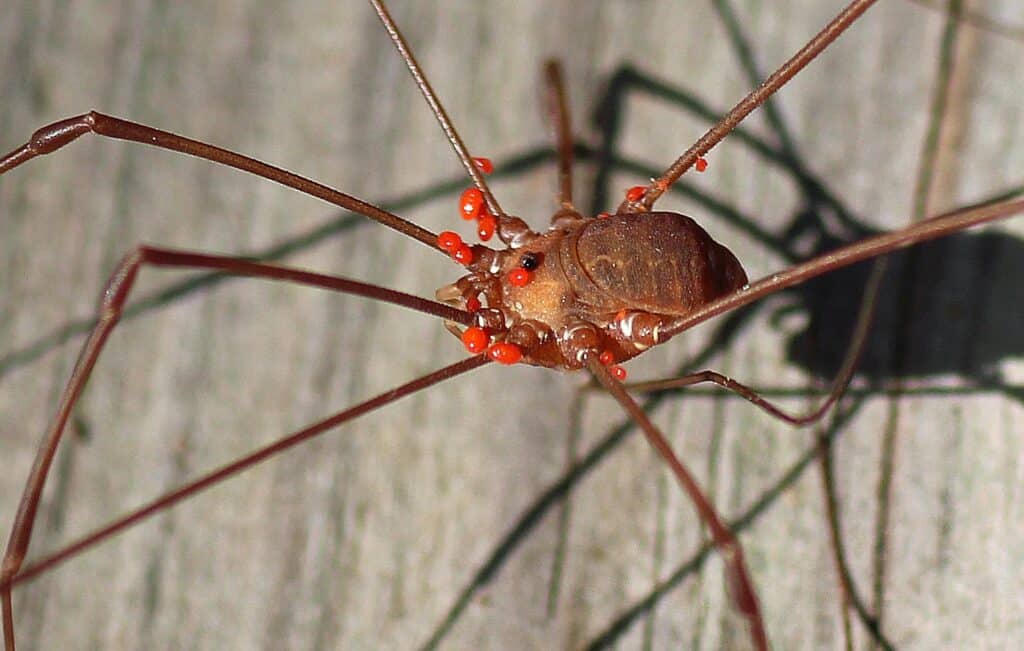Harvestmen are captivating arachnids that belong to the order Opiliones. While often mistaken for spiders due to their long legs, they are a distinct group with unique characteristics and behaviours. In this comprehensive article, we will delve into the world of harvestmen, exploring their anatomy, habitat, diet, reproduction, defence mechanisms, cultural significance, and more. Prepare to be amazed by the intriguing world of these enigmatic creatures.
Introduction to Harvestman
Harvestmen are ancient creatures that have roamed the Earth for millions of years. They are not spiders, despite their appearance, and belong to a different arachnid order. Their distinguishing feature is their compact body structure, where the cephalothorax and abdomen are fused together. This characteristic sets them apart from true spiders, scorpions, and other arachnids. With over 6,600 known species, harvestmen display an incredible diversity of forms and adaptations.
Anatomy and Physical Characteristics
Body Structure
The unique body structure of harvestmen is the result of millions of years of evolution. Their fused body allows for flexibility and efficient movement, enabling them to navigate various terrains with ease. The abdomen and cephalothorax fusion is so complete that, at first glance, harvestmen appear to have just one body segment, which sets them apart from other arachnids.
Legs and Movement
Harvestmen possess eight long and slender legs, each equipped with sensory organs called trichobothria. These specialised hairs allow them to detect vibrations and air movements, aiding in locating prey and sensing potential threats. With their exceptional leg coordination, harvestmen can walk, climb, and even leap, displaying impressive agility. In certain species, their legs can be longer than their bodies, giving them an extraordinary range of motion.
Sensory Organs
The trichobothria located on the legs play a crucial role in the harvestmen’s sensory perception. These sensory organs are incredibly sensitive, allowing them to detect the slightest changes in their surroundings. Through the trichobothria, they can distinguish between various environmental cues, enhancing their survival and hunting abilities. Additionally, their legs are covered in fine hairs that act as chemoreceptors, helping them detect chemical cues in their environment.

Habitat and Distribution
Geographic Range
Harvestmen have a global distribution, inhabiting almost every continent on Earth. From the depths of dense rainforests to arid deserts, these versatile arachnids have managed to thrive in diverse ecosystems. However, their distribution is uneven, with certain regions boasting higher species diversity than others.
Preferred Habitats
These adaptable creatures can be found in an array of habitats, including forests, grasslands, caves, and urban areas. They prefer dark and sheltered environments, such as leaf litter, under stones, tree bark, and crevices, where they can hide from predators and harsh weather conditions. In urban settings, they often seek refuge in buildings, cellars, and other structures.
Nocturnal Behaviour
Harvestmen are primarily nocturnal, meaning they are most active during the night. This behaviour helps them avoid predators and conserve energy during the warmer daylight hours. As the sun sets, they emerge from their hiding spots to forage for food and engage in mating rituals. Their preference for nighttime activities is also linked to temperature regulation, as they are ectothermic creatures that rely on external heat sources.
Diet and Feeding Habits
Carnivorous or Herbivorous?
Harvestmen are predominantly carnivorous, preying on a variety of small insects, spiders, mites, and other arthropods. They are effective hunters, using their keen senses and agile legs to track down and capture their prey. While most harvestmen are carnivorous, some species occasionally consume plant matter as well. The presence of both predator and scavenger species within the group highlights their adaptability to different food sources.
Feeding Strategies
Unlike spiders that use silk to immobilise their prey, harvestmen lack silk glands and rely solely on physical means to subdue their victims. Once they catch their prey, they use their chelicerae to grasp and crush it before consuming it whole. This feeding strategy is highly effective, allowing them to quickly dispatch their prey. Additionally, some harvestmen possess a unique feeding behaviour known as “mucus-feeding,” where they secrete digestive fluids onto their food to break it down before ingestion.

Reproduction and Life Cycle
Mating Behavior
During the mating season, male harvestmen engage in elaborate courtship rituals to attract females. These courtship displays often involve intricate dance-like movements and tactile interactions. Once a female is receptive to mating, the male transfers a spermatophore containing sperm to the female’s genital opening. This process ensures successful fertilisation and enhances the chances of passing on their genes to the next generation.
Egg Laying and Development
After successful mating, the female harvestman lays eggs, which she carefully guards and protects. She attaches the eggs to various surfaces, such as leaves or tree bark, to keep them safe from predators and environmental hazards. The eggs eventually hatch, giving rise to tiny, six-legged nymphs. The nymphs go through several moulting stages, shedding their exoskeletons as they grow, before eventually reaching adulthood. The duration of their life cycle can vary significantly among species, with some completing their development within a few months, while others take several years.
Defence Mechanisms
Camouflage and Mimicry
One of the primary defence mechanisms of harvestmen is their remarkable ability to camouflage themselves. Some species have evolved colour patterns and body shapes that closely resemble twigs, bark, or other natural elements in their surroundings. This form of camouflage helps them blend seamlessly into their environment, making it difficult for predators to detect them. Additionally, certain species engage in postural mimicry, assuming specific body positions to mimic inedible or harmful species, thereby deterring potential predators.
Chemical Defences
In addition to camouflage, certain species of harvestmen possess specialised glands that produce noxious chemicals as a defence against predators. These chemicals can deter or repel potential attackers, providing the harvestmen with an added layer of protection. Some species release their chemical defences when threatened, emitting a strong odour or a bitter taste that discourages predators from approaching.
Relationship with Humans
Economic and Ecological Importance
Harvestmen play a vital role in maintaining the balance of ecosystems. As predators of various insects and arthropods, they help control the populations of potential pests. In agricultural settings, they contribute to pest management, reducing the need for chemical pesticides. Moreover, their role as decomposers, feeding on dead plant and animal matter, aids in nutrient cycling within ecosystems.
Misconceptions and Fears
Despite their harmless nature, harvestmen often evoke fear and misconception among humans. Their spider-like appearance and long legs can lead to unwarranted concerns. However, it is essential to recognise that harvestmen are not venomous and pose no threat to humans. In reality, they are beneficial organisms that contribute positively to the environment.
Similarities and Differences with Spiders
Taxonomy and Classification
While harvestmen share some similarities with spiders, they belong to a different arachnid order. Spiders fall under the order Araneae, while harvestmen belong to Opiliones. This distinction is based on differences in body structure and other characteristics. Despite this taxonomic difference, both groups play essential roles in ecosystems and have fascinating adaptations.
Contrasting Characteristics
One of the most significant differences between harvestmen and spiders is the fused body structure of the former. Spiders have distinct cephalothoraxes and abdomens, while harvestmen have a single unit that combines both these body regions. Additionally, harvestmen lack silk-producing glands and do not spin webs for hunting or building shelters. Instead, they use their silk glands to produce adhesive silk threads that aid in sperm transfer during mating.
Fascinating Facts about Harvestmen
Parental Care
Some species of harvestmen exhibit remarkable parental care. The females play an active role in caring for their eggs and young, ensuring their survival during the vulnerable stages of development. The presence of parental care in certain species is relatively uncommon among arachnids and showcases their diverse reproductive strategies.
Ancient Creatures
Harvestmen have a rich evolutionary history, with fossil evidence dating back millions of years. Their ability to adapt and survive through various geological periods showcases their resilience as a group. They have existed on Earth long before the appearance of many other terrestrial arthropods, making them true survivors of evolutionary time.
Conservation Concerns
Threats and Challenges
Currently, harvestmen do not face significant conservation threats. However, habitat destruction and environmental changes could pose risks to their populations in the future. As human activities continue to impact natural habitats, it is essential to monitor harvestmen populations and protect their diverse ecosystems.
Conservation Efforts
Conservation efforts aimed at preserving natural habitats and raising awareness about the importance of harvestmen in ecosystems can contribute to their long-term survival. As integral members of various food webs, their presence and abundance can indicate the health of their habitats and broader ecological systems.
Interactions with Other Species
Predators and Prey
Harvestmen interact with a diverse range of organisms in their ecosystem. They serve as prey for various predators, including birds, small mammals, and other arthropods. Simultaneously, they act as predators, controlling populations of insects and other small arthropods. Their interactions with other species play a crucial role in the stability and functioning of ecological communities.
Symbiotic Relationships
Some harvestmen have symbiotic relationships with other organisms. For instance, certain species of mites hitch a ride on harvestmen, using them as a means of transportation to new locations. Additionally, some harvestmen form mutualistic relationships with pseudoscorpions, where both species benefit from their association.

Cultural Significance
Myths and Folklore
Throughout history, harvestmen have been the subject of numerous myths and superstitions in different cultures. In some cultures, they are considered symbols of good luck or bringers of bad omens. Folktales often depict harvestmen in various roles, ranging from clever tricksters to mystical beings.
Symbolism in Different Cultures
Harvestmen have held various symbolic meanings across cultures. From ancient beliefs to modern superstitions, they have been associated with different aspects of human life and the natural world. Their presence in folklore reflects the fascination and mystery they evoke in human societies.
Research and Scientific Studies
Contributions to Science
Harvestmen have piqued the interest of scientists and researchers due to their unique characteristics and behaviours. Studies on their anatomy, behaviour, and evolutionary history have contributed valuable insights to the field of arachnology. By studying harvestmen, scientists can gain a better understanding of arachnid biodiversity and evolution.
Ongoing Studies
Ongoing research on harvestmen continues to shed light on their diverse species, behaviour, and ecological roles. Scientists are continually discovering new aspects of these enigmatic creatures, enriching our knowledge of their natural history and the ecosystems they inhabit.
Conclusion
Harvestmen are an extraordinary group of arachnids that deserve our admiration and appreciation. From their ancient lineage to their fascinating adaptations, they provide us with a glimpse into the wonders of the natural world. By understanding and respecting these creatures, we can foster a greater sense of harmony with the environment and the diverse organisms that share our planet.
Additional Resources
Sam loves to learn about animals and their habitats. He has been a nature lover from a very young age, and has been writing papers and articles about wildlife for as long as he can remember.
